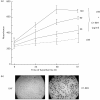Endothelial targeting with C1-inhibitor reduces complement activation in vitro and during ex vivo reperfusion of pig liver
- PMID: 11737055
- PMCID: PMC1906211
- DOI: 10.1046/j.1365-2249.2001.01695.x
Endothelial targeting with C1-inhibitor reduces complement activation in vitro and during ex vivo reperfusion of pig liver
Abstract
Tissue damage during cold storage and reperfusion remains a major obstacle to wider use of transplantation. Vascular endothelial cells and complement activation are thought to be involved in the inflammatory reactions following reperfusion, so endothelial targeting of complement inhibitors is of great interest. Using an in vitro model of human umbilical vein endothelial cells (HUVEC) cold storage and an animal model of ex vivo liver reperfusion after cold ischaemia, we assessed the effect of C1-INH on cell functions and liver damage. We found that in vitro C1-INH bound to HUVEC in a manner depending on the duration of cold storage. Cell-bound C1-INH was functionally active since retained the ability to inhibit exogenous C1s. To assess the ability of cell-bound C1-INH to prevent complement activation during organ reperfusion, we added C1-INH to the preservation solution in an animal model of extracorporeal liver reperfusion. Ex vivo liver reperfusion after 8 h of cold ischaemia resulted in plasma C3 activation and reduction of total serum haemolytic activity, and at tissue level deposition of C3 associated with variable level of inflammatory cell infiltration and tissue damage. These findings were reduced when livers were stored in preservation solution containing C1-INH. Immunohistochemical analysis of C1-INH-treated livers showed immunoreactivity localized on the sinusoidal pole of the liver trabeculae, linked to sinusoidal endothelium, so it is likely that the protective effect was due to C1-INH retained by the livers. These results suggest that adding C1-INH to the preservation solution may be useful to reduce complement activation and tissue injury during the reperfusion of an ischaemic liver.
Figures





References
-
- Gridelli B, Remuzzi G. Strategies for making more organs available for transplantation. N Engl J Med. 2000;343:404–10. - PubMed
-
- Belzer FO, Southard JH. Principles of solid-organ preservation by cold storage. Transplantation. 1988;45:673–6. - PubMed
-
- Jaeschke H. Preservation injury: mechanisms, prevention and consequences. J Hepatol. 1996;25:774–80. - PubMed
-
- Menasche P, Termignon JL, Pradier F, et al. Experimental evaluation of Celsior, a new heart preservation solution. Eur J Cardiothorac Surg. 1994;8:207–13. - PubMed
-
- Orak JK, Singh AK, Rajagopalan PR, Singh I. Morphological analysis of mitochondrial integrity in prolonged cold renal ischemia utilizing Euro-Collins versus University of Wisconsin preservation solution in a whole organ model. Transplant Proc. 1994;26:122–5. - PubMed
Publication types
MeSH terms
Substances
LinkOut - more resources
Full Text Sources
Other Literature Sources
Miscellaneous

